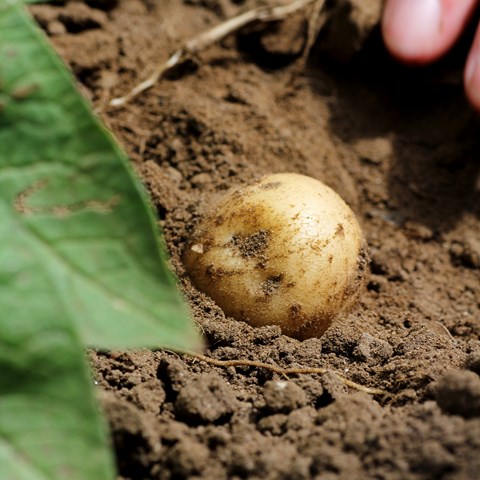Facts:
Scientific paper
Chawade, A., Alexandersson, E., Bengtsson, T., Andreasson, E., & Levander, F. 2016. Targeted proteomics approach for precision plant breeding. Journal of Proteome Research 15(2): 638-646

It’s possible to analyze plant proteins to find out which plants are the best to cultivate. Researchers at the Swedish University of Agricultural Sciences and Lund University develop methods for this, and they have found proteins in potato typical for high yield, and resistance against late blight. They suggest a new workflow, including both DNA- and protein analyses, to accelerate the breeding for important crop traits.
Senior lecturer Fredrik Levander, at the Department of Immunotechnology at Lund University, is one of the researchers behind a new study showing that it is possible to determine which potato plants are high-yielding, and which are resistant to late blight, by analyzing the potato plants' proteins.
– It can be tricky to predict the cultivation characteristics of, for example, a potato by just looking at genes. Proteins bring us closer to what actually happens when the plant grows. Although, at the same time, it is experimentally easier to measure DNA variations, he explains.
Using mass spectrometry, more specifically the technology selected reaction monitoring, it is possible to find out the amounts of selected peptides and proteins in a plant. First of all, it is important to find out which of these molecules are specific to the plants with good properties. Then, plant breeders can use the peptides and proteins as markers for the properties such as resistance to disease, drought tolerance or adaptation to a particular region.
The markers can thus tell the plant breeder what properties the plants have, without having to wait and identify the properties per se, among the grown up plants. This saves energy, time and money.
There are already methods for making selections based on the genome, using DNA markers. But the researchers see benefits of supplementing DNA markers with protein markers. The proteins say more about which biological processes are "going on" in the plant, compared to DNA markers. Some genes are not expressed, and some genes give rise to several different proteins.
– There are often several copies of genes present in plant genomes, and several variants of genes that are very similar to each other. That makes it difficult to predict plant characteristics from DNA. Especially in plants that are tetraploid, hexaploid, and so forth, says Fredrik Levander.
You get closer to the truth with protein analyzes, compared to DNA analyzes, but it's trickier to analyze the proteins. DNA sequences consist of four different bases, and there are easy methods for amplifying large amounts of DNA. The proteins consist of many more constituents (amino acids), and the researchers are limited by how much protein they manage to get from a leaf or a potato tuber.
- Different proteins behave very differently, therefore it is more complicated to analyze them, compared to analyzing DNA.
In the current study, the researchers selected 104 protein markers. Some of these could be used to predict higher potato yield, and resistance to the oomycete Phytophthora infestans causing late blight in foliage and tubers. In other words, they found protein markers for properties for which there are no commercial DNA markers yet.
The study was published in Journal of Proteome Research. It was funded by Mistra Biotech and the Swedish Foundation for Strategic Research.
Contact:
Fredrik Levander, Senior lecturer
Department of Immunotechnology, Lund University
Erik Andreasson, Professor
Department of plant protection biology, Swedish University of Agricultural Sciences
Scientific paper
Chawade, A., Alexandersson, E., Bengtsson, T., Andreasson, E., & Levander, F. 2016. Targeted proteomics approach for precision plant breeding. Journal of Proteome Research 15(2): 638-646
mistrabiotech@slu.se
+46 (0)18 672232